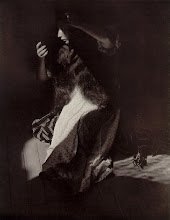Geir Moseid - Plucked

A handful of loose petals cover a white stained tablecloth. The hands of a woman embroider delicate little flowers into a piece of fabric. A woman wearing a patterned dress is in the act of putting white sheets onto a bed. Food lies uncooked on a kitchen counter as the sun casts shadows through a net curtain composed of small flowers above. A table of partly consumed food and drink lacks the necessary human element to bring it to life and a piece of flower-patterned wrapping paper lies to waste.
Geir Moseid’s new exhibition, ‘Plucked’ at Flowers East is on first appearances strangely deceptive in its formal simplicity. On display is a collection of photographs, which draws upon the idea of the home and our relationship with its various spaces to produce an effect that is both intriguing and genuinely disquieting. The Norwegian born photographer claims that his work is based around the ethics of both social documentary and staged photography and what is immediately noticeable is Moseid’s excellent eye for detail.
He also states that what he really wants to do is evoke a feeling of the uncanny, drawing upon the duality perceived by such a place as the home. Moseid’s photographs are highly formal in style, using very little colour or tonal variation. The effect is a heightened sense of unease as the viewer attempts to understand what is really going on in each scene. These may be homes, but they are far from comforting places.
One of the main themes of the exhibition is the passing of time. There are memento mori references in the use of flowers, empty tables and uncooked food. Use of food devoid of human activity becomes a subtle reminder of our own fate. The woman’s hands are a reminder of our need to literally weave our surroundings into our life as an attempt to counteract our own mortality. It is a way of making our mark on the world.
Despite the occasional figure, these photographs lack a human element. The figures that are present are always turned away or hidden from us. Never do we see a face. Captured in the past, they appear like ghosts or perhaps more appropriately a collection of indistinct memories. This creates an interesting dichotomy between the nature of photography itself and its ability to document daily life and capture a single moment in time and its ability to be manipulated, both in pre- and post-production.
In the staging of the photographs, there is something of a Cindy Sherman feel about, but where her works confront the viewer head on with a portrait, Moseid’s have a far greater voyeuristic element. He is much more interested in what we can and cannot see. There is something very disquieting about a space that should be familiar, but because of those elements that remain just out of sight it makes the inverse is true.
Moseid chooses a viewpoint, which puts us in the position of the home or the internal space through which we see the outside world only through a very narrow divide. What’s more is that the world outside is even more obscured by the raindrops, which fall against the window. It is only with the home with which we have a sense of control over our surroundings. It’s how we use that control to carry out our desires in such a private setting that forms the basis of Moseid’s work.
Taken as a whole, the work begins to have quite a hypnotic effect and you find yourself making elaborate connections between the images. The image of the person in the bath is a very private act in itself, but coupled with the flannel which obscures his or her face, we lose a sense of their identity. The question then arises as to why this person has chosen to hide their face. It is a far more physical act of blocking out sight than simply closing ones eyes. Is this act a way of hiding from an overwhelming sense of regret or is it a way of hiding something physical from the world. Coupled with the image of the woman in the bed, it’s possible to make a rather sinister connection. Turned away from the viewer and exposing her back, instead of an image of a sleeping woman, there’s now almost a sense that perhaps she’s not sleeping, but trying to turn her back on the past and crying into the pillow. This is where Moseid’s talent for exploring the duality of the home environment in terms of documentary and staged photography resides.
These photographs are paradoxically simple and complex. They deal with the fragile nature of human life and all its sinister undersides. Truth is subjective and as Samuel Beckett said, ‘It is only possible to verify a fraction of what has been said.’ Moseid draws inspiration from TV and cinema, which obviously has a big influence on most people’s lives today and his photographers play with expectations, using our love of drama and search for knowledge to undermine that very idea of objective truth. The past is indeed the past, regardless of how we try to recreate it.
'Plucked' is on at Flowers East until 18th Oct.



0 comments:
Post a Comment